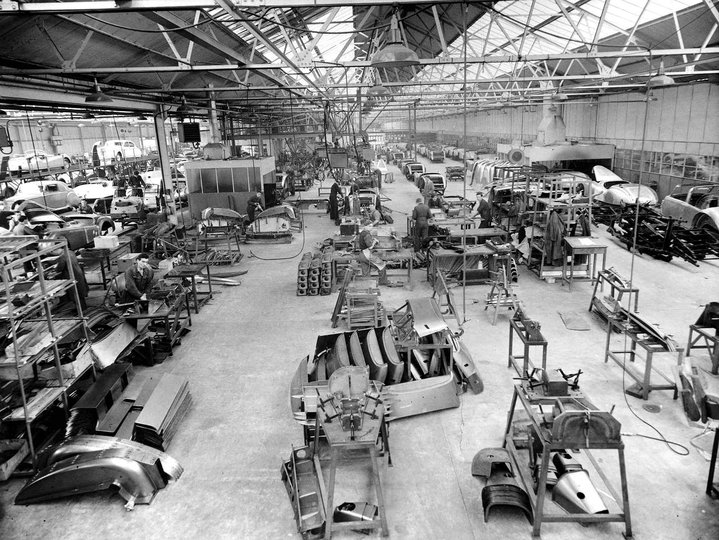Was the rear fender welting painted with the fenders installed on the body? …in situ?
Yes.

Thanks. …aaaand 20
While the cars were painted with the rear fenders in place, I believe there’s evidence that they were only attached loosely and that the “body-colored” piping was attached/inserted later. Urs Schmid’s Volume 1, page 233 shows the colored piping. If the piping were in place, at the time the car was painted, it certainly would end up bonded to the fender and/or the body itself. It’s very important the both the body and the fender get a good coat of paint in their “overlapping/joining” area, as it is very prone to trapping dirt and rusting.
I vote for not installing the piping until after the car is painted.
Dick
I once owned an MGA and had it repainted with front and rear fenders loose so as to install the piping afterwards. My experience with leaving the vinyl/ rubber piping unpainted was that it would out-gas a sort of grime over a period of time, attract dirt and have to be cleaned with mineral spirits. And yet, painting the car with the piping on seems like it would complicate proper paint coverage where it’s needed most at the joins. So, I, too am curious to know as to how others have their cars configured. And where can colored piping be found anyway? In my case, old English white.
Unless you have some custom-made rexine-covered piping, it’s just a matter of buying the available black vinyl piping, separately painting it body color and installing it when you’re done painting and finishing the body and fenders…
Dick
Just had my 120 done. The wings and the body shell were painted separately. The trimmer made the piping by wrapping a refine like material around some rubber piping. The painter then added some plasticiser to the body paint and painted the resultant piping body colour. It was very successful.
I know that painting the wings separately from the body was not what the factory did but we are not mass producing the cars and can afford to be a little more fussy.
Tim
I’m with Tim. In another post I go over today’s 140 examination. I really don’t like seeing beading painted over like this, it looks very amateurish.
In factory SS and MKIV jag pics they are clearly shown with panels painted separately.
True up through and including Mark V. Note the Mark V wings/bonnets paint trolley in the foreground of the first picture.
With XK120 they seem to have begun a transition in things.
Notice the one on the far right in the second picture has the skirt on.
These two shots are at Foleshill. The ones on the rotisserie are at Brown’s Lane.
This may be another one of those questions where each of us has hold of a small piece of the story. We may never really know the whole story.
It occurred to me that there are really two questions here.
- What did the factory do (and not do) to build the cars initially?
- What should we do to restore the cars now?
It would be a fatal error to assume that the factory did everything the same from 1949-1961 on all XK bodies.
It would be another fatal error to assume the factory had in view the possibility that these cars would have a lifetime of 6 decades.
Have a better file on these to upload?
I’ll be addressing this painted welting problem this winter. Having a silver metallic car, I decided on silver interior vinyl paint, plan in using 70’s Corvette silver interior paint on light gray vinyl piping. It’s flexible enough for seats so it should be good for this. It’s not going to be shiny but it looks to be a good match. Any color shade is possible with interior or vinyl top paint.
Anyone hear of anyone doing it this way?
I’ve seen MGAs and a few hot rods that used a treated paint on vinyl (sewn) beading. It really allows for the best paint and polish (tins off the car) at the edges and gets rid of that paint bridge at the gap.
I would suggest going to your local auto paint supplier and get some flexible primer used on plastic parts and bumper covers. Then color coat with whatever is the paint system for your car. I works just fine.
Flex additive in paint works much better than one would expect. We painted a 150 OTS Claret and painted the fender welting to match. As a test we tied the welting in a knot with no cracking or flaking of the paint.
The original fender beading from my December ‘53 production XK120 is entirely painted, suggesting a separate treatment. I cannot imagine the beading being painted in situ and looking right.
The vinyl welting from my 5 / 54 120 OTS is extruded coloured vinyl not coloured rexine. I believe you will find it is only the early cars which had the rexine fender welt. Yes you are correct putting an elasticiser in the paint works, I did a colour change on my 120 from pastel blue to grey and had this done in the 80s still fresh today.

